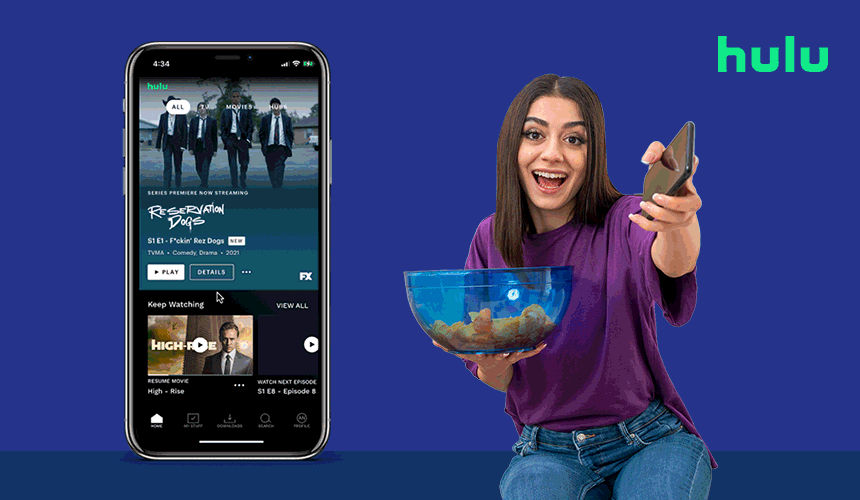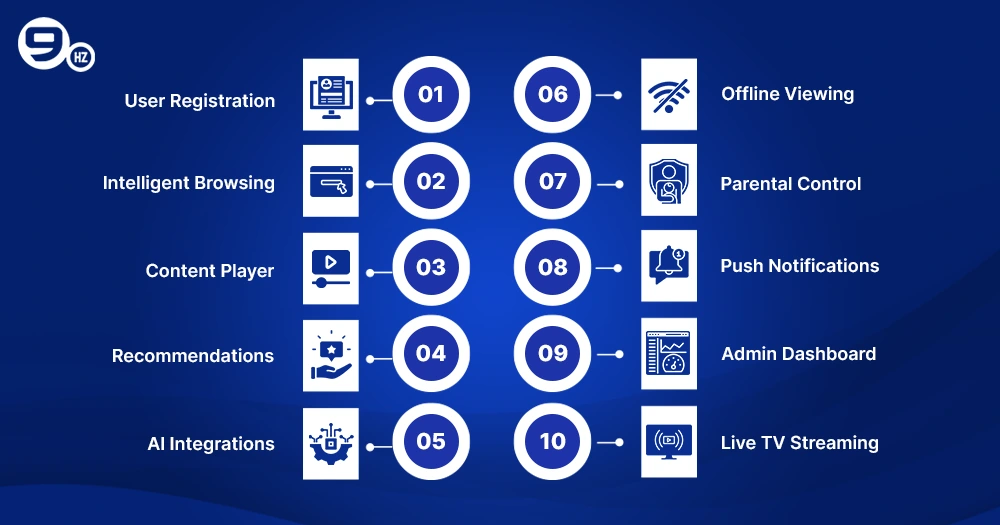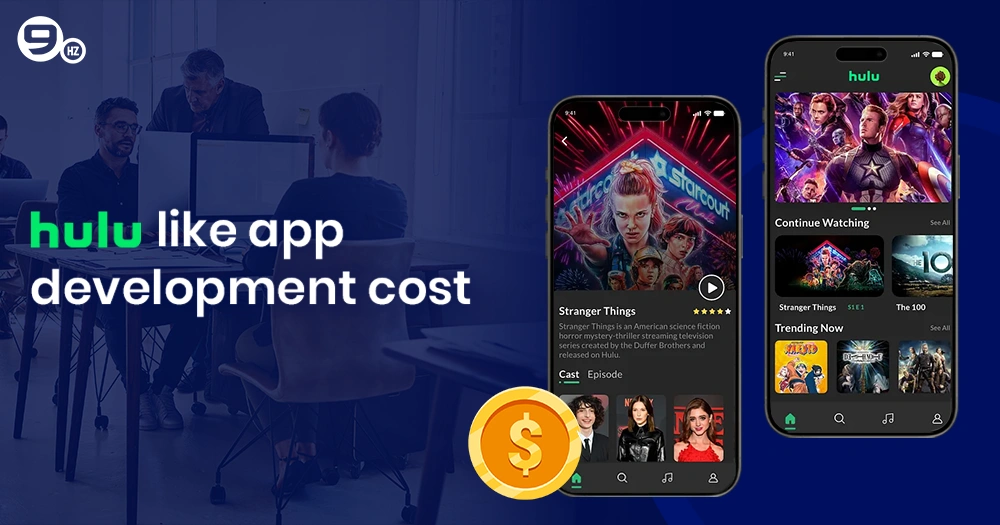Have you ever wondered how Hulu transformed from a basic onse-demand television provider into the biggest on-demand streaming service in the United States, competing with Netflix and Disney+? With binge-watching becoming the new norm and viewers wanting control over what, when, and how they consume media content, streaming platforms like Hulu are now an entertainment and revenue gold mine, which indicates that this is the right time for you to build an app like Hulu.
As per a report by Statista, the global video streaming service market generated over $100 billion in revenue in 2023 and is projected to reach $416 billion by 2030, growing over 19.3%. This paradigm shift to digital consumption instead of traditional consumption from all content providers has heavily impacted the market. As consumers now expect personalized recommendations and mobile access to content, they have forever changed the landscape of what streaming platforms and app development can provide and how lucrative the business models for development can be.
While many businesses are still contemplating the idea, the streaming space has become quietly saturated with smarter, bolder apps waiting in the wings to captivate audiences. The sooner you get in, the better chance you have to build brand loyalty before it turns stale.
If you are curious about how to create an app like Hulu, this guide provides an overview of everything from the architecture and key features of the Hulu platform to what it is going to cost to build an app like Hulu, and how to effectively monetize it. Let’s dive in!
What is the Hulu App?
One of the best video streaming apps, Hulu is a subscription-based video-on-demand streaming service with a wide range of shows, movies, live TV, and original content. Since its launch in 2007, Hulu has become popular because it provides on-demand access to current or past episodes of popular television shows. Many of these episodes were available as soon as the day after they aired on network television, even for shows on other networks.
What sets Hulu apart from other streaming services is its offering of live TV streaming and on-demand viewing. Subscribers have the option of following their views live stream as well as on demand. Subscribers can also choose from a variety of different subscription plans, including ad-supported as well as ad-free views, which makes it easy to find an affordable subscription plan relative to a subscriber’s needs.
Hulu has also spent a great deal of money on original content, alongside licensed content from large studios. For example, The Handmaid’s Tale has been incredibly popular from a viewer and critical perspective. Hulu’s approach to sparse (yet personalized) recommendations, intuitive UI, and multi-device experiences has made it the preferred and most recognizable app for the video streaming space in the United States.
Hulu continues to forecast both subscriber growth and overall growth across the service, partially because of a flurry of strategic partnerships and new features. Hulu represents a significant success story in the video streaming market (with over 48 million subscribers as of 2024), and offers anyone who wants to create an app like Hulu an easy pathway via diversification of content, original content features, user enabling features, and flexible pricing as needed.
Future Predictions and Projections of the Video Streaming Industry
In the past decade, the video streaming market has experienced tremendous growth, fundamentally altering how millions of people around the world consume entertainment, and this growth does not show any signs of slowing. In fact, according to market researchers, there will be continuing growth in the video streaming market. The anticipated expansion will be fuelled primarily by new technology, changing patterns of consumer behavior, and increases in global internet penetration.
According to Grand View Research, the global video streaming market was valued at just under 74 billion dollars in 2023 and is projected to grow to more than 223 billion dollars by 2030, which means a compound annual growth rate (CAGR) of approximately 16.3%. Factors contributing to the growth rate include:
- Firstly, there is the proceeding increase in consumer demand for content that is more convenient and has a level of personalization. This doesn’t just mean the ability to binge-watch an individual series; people want to watch shows and movies on their schedule across multiple devices – mobile phones, tablets, smart TVs, and laptops. The more choices of what to watch on the go, and the more flexible the viewing habits become, the more readily subscriptions and activities will increase for streaming platforms.
- Secondly, the bandwidth technology environment is fast evolving across the world and “smart” devices are proliferating. These two trends are important as streaming services gain momentum and reach more viewers in regions like Asia-Pacific and Latin America, where there are increases in broadband availability and smartphone service penetration.
- Thirdly, the increase in original and exclusive content is changing the competitive environment. Companies are spending millions on their own shows and movies that can’t be found anywhere else, like Hulu, Netflix, and Amazon Prime Video – all of whom are trying to build subscriber loyalty around original and exclusive content. It’s a primitive economic reality.
- Fourthly, technological advances like artificial intelligence (AI), machine learning (ML), or better connectivity with 5G not only allow more personalized suggestions/engagement, but also provide faster speeds and features associated with the content, like interactive storytelling or other forms of virtual reality (VR).
Looking into the future, industry analysts track the following trends likely to influence video streaming:
- Hybrid Monetization Models: Platforms will continue to conflate subscription-based, advertising-supported, and transactional revenue models to capture the highest profitability while accommodating the largest possible variety of user preferences.
- Greater Personalization: AI-backed recommendation engines will advance towards hyper-personalized recommendations based on the viewer’s brand of preferences and viewing history.
- Continued Global Expansion: Streaming services will increasingly focus on localization, with respect to regional content availability and localization, to be able to capture unexplored aspects of as yet unmonetized international markets.
- Interactive and Social Features: Additional viewer engagement and retention will derive from the integration of social sharing, watch parties, and other member-oriented interactive content features.
- Sustainability Initiatives: Sustainability will become increasingly paramount to streaming establishments as they adopt greater green technologies and habits to reduce their contribution to the carbon footprint.
In light of the previous projections, there is a tremendous opportunity to create an app like Hulu. The key to success is to better understand the industry dynamics, consumer expectations, and the technological advancements that shape the market.
If you desire for your streaming app to compete in the streaming space, you will need to correlate your strategy for development in alignment with these trends. This demonstrates that investments in scalable infrastructure, attention to the quality of the content, and the inclusion of cutting-edge technological features that continue to offer better user experiences can significantly shape your bang for your buck.
It is safe to say, the video streaming space is not only growing in size, but also growing increasingly complex and sophisticated. A company’s success will come from its ability to adapt and influence value in what appears to be a serious opportunity for growth in the coming years!
How to build an app like Hulu?- step by step
Building your streaming app like Hulu is tricky, but also thrilling. To create an app like Hulu, you should use a strategic approach to cover technology, content, user experience, and monetization. To develop an app like Hulu, there is a process to follow that will set your app apart from the other video streaming apps in the industry.
The following are the steps to help you build an app like Hulu:
1. Market Research and Competitor Analysis
Before starting the development process, you should do thorough market research to understand your target audience and their preferences and deal with current trends in the streaming industry. Conduct a thorough analysis of competitors of Hulu, such as Netflix, Disney+, and Amazon Prime. Once you collect external information on their strengths and weaknesses, you can define what you will put forth as your unique selling points (USPs). You can use information from your research to avoid their mistakes, too.
Pro Tip: Search out content gaps or underserved niches where your app can thrive, whether it is regional content, live sports, or interactive shows.
2. Establish Core Features and Functionality
List the core features that your app must provide. In order to build an app like Hulu, you will need to provide core functionality such as the following:
- User registration and accounts
- Content library, which may include categories and genres
- Search and filtering
- Personal recommendations
- Video player with adaptive streaming
- Download video for offline viewing
- Live TV (optional)
- Support multi-device experiences
- Parental controls
- Push notifications
- User ratings and reviews
These features will drive the user experience overall, as well as the ability to attract and retain subscribers.
3. Decide on a Monetization Strategy
Hulu has multiple revenue sources, such as subscription fees and ad-supported content. Decide what type of monetization strategy you will use soon because it can affect how you design the app and the overall architecture of the backend. Here are the various monetization models you can pick from:
- Subscription-based (SVOD): Users pay a monthly fee for unlimited access.
- Ad-supported (AVOD): Users watch free content but are interrupted by ads that will be displayed.
- Transactional (TVOD): Users pay for the right to access and view a piece of filmed content, or rent a video at a time.
- Hybrid: A combination of any of the above-mentioned.
The choice of the monetization model will impact your design and your app’s back-end architecture accordingly.
4. Create an Intuitive User Interface and Experience
The interface must be intuitive and visually appealing. Consider how users will navigate your platform as well as how users engage with and discover new content. The design should be responsive — you need to consider viewability across devices, and how colors and layouts resonate with your brand. Also, think about features like autoplay previews, watchlists, and intuitive controls for enhanced user experience.
Practical tip: In this phase, it is useful to conduct user testing with a prototype to gather feedback and adjust the design as needed.
5. Build the Backend of the App
The backend is the core of your Hulu-like app. It handles the video content, user data, subscription management and reporting, and analytics. Ideally, your app’s backend is in the cloud (Amazon Web Services (AWS), Google Cloud, Microsoft Azure, or similar) to deal with potentially massive amounts of streaming traffic, storage, and security. Usually, it will consist of the necessary Application Program Interfaces (APIs) to provide real-time content management, user authentication, payments, etc.
Note: Security should be treated as critical. Data should be encrypted, payment gateways secure, and governed by relevant regulations (GDPR, etc.).
6. Build the Frontend of the App
Your app’s frontend will consist of the interface across multiple platforms that your users will use — web browsers, Android, iOS, smart TVs, etc. You can choose to build for each operating system independently (best for performance), or use a cross-platform solution like React Native or Flutter (with the reduction of effort and faster timelines as a goal) to build for multiple platforms.
7. Integrate a Content Delivery Network (CDN)
To meet the user demand for ultra-fast streaming (with no buffering), it’s important to consider integrating a content delivery network (CDN) designed to deliver video content with low buffering latency. CDNs use numerous data centres across the globe, which significantly reduces any latency, as well as providing your users with video quality capabilities regardless of their location.
8. Implement the Video Player and Streaming Protocols
Select or develop your video player that supports adaptive bitrate streaming (ABR), meaning the video will adjust automatically based on the user’s internet speed and will support formats that have wide applicability, like HLS or DASH.
9. Test Extensively
You should run a series of testing – functional, usability, performance, security, for example – on multiple devices before you go live, and fix bugs and optimize load times, in order to ensure your app is running as well as you can under multiple conditions.
10. Launch and Drive Interest in Your App
Once you have your launch plan in place – including digital marketing strategies for promoting your app using partnerships, influencers, advertising, and promotions to raise awareness – consider the static option of a phased launch or rolling the app out to only specific locations first.
11. User Support and Updates After Launch
Post launch, you will still want to track user feedback and check analytics. You will also want to continually update your app to keep offering new features, performance improvements, and new content, to drive continued interest in your app.
Features to Create an App Like Hulu
To create an app like Hulu, it’s not enough to simply stream video, you’ll need to recreate that intuitive, immersive experience that keeps people coming back to Hulu by the millions. That experience comes from a complex combination of core functionality, smart technology, and thoughtful design that need to be seamlessly integrated to add value. We will take a close look at the must-haves that are the foundation of a successful Hulu-like custom mobile app development, and we will point out enhancements that can make your app any more competitive in the crowded video streaming space.
1. Easy User Registration & Profiles
The first experience of user interaction, registration, is at the heart of user experience. It can be done through registration via email, mobile, or social logins, which would include Google, Apple, or Facebook. One thing that Hulu offers, which is unique, is multiple user profiles under one account. This is advantageous for families or any shared living situation. Now everybody in the household can have a watchlist, watch history, & user preferences that personalize their experience based on viewing behaviour.
2. Intelligent Browsing and Sophisticated Searching
Browsing content should feel simple, not tedious. Hulu groups its content in categories that provide visual cues (i.e., “Trending”, “Just Added”, “Because You Watched”, etc.). When users want to quickly narrow down their viewing options, new interfaces with a robust search engine combining filters, voice commands, and predictive suggestions will refocus users’ searches. To build an app in a similar capacity to Hulu, it is vital to support smart navigation, as this contributes to lower bounce rates and higher watch times.
3. User-Friendly Content Player and Viewing Options
The actual streaming experience must be user-friendly and customizable for each viewer. Basic playback features include pause, rewind, fast forward, and auto-play options. In addition to that, the ability to toggle subtitles, audio options, and video quality gives users the ability to tailor their experience. In 2022/2023, many modern apps also included adaptive streaming, which adjusts resolution in real-time based on bandwidth, an essential feature to ensure uninterrupted viewing.
4. Personalized Recommendations and AI integrations
One of the biggest reasons Hulu retains its users is because of its robust content recommendation engine. It can use watch history, user ratings, time spent in a genre, device used at the time of viewing, and many other relevant parameters to give users hyper-personalized recommendations. Implementing AI-driven recommendation engines isn’t just a trend; at this point, it’s a requirement! If you’re looking to create an app like Hulu, this is a place where you’re going to build stickiness and brand loyalty. Apps that “know” the user and suggest what they’d be inclined to look at enjoy longer average session lengths. Here is an ultimate guide on AI in OTT.
Pro tip: Use collaborative filtering and machine learning algorithms to predict what content a user will like. This increases user satisfaction and maintains reduced churn over time.
5. Download for Offline Viewing
One more thing to touch on is whether you offer the ability to download content for offline viewing. It’s expected at this point and is not optional. People want to watch content on aero planes, on public transit, and in places where there is no access to wi-fi or poor internet connection in general. Hulu does this on premium plans, and if you are trying to create an app like Hulu, you should consider it.
Note: You’ll have to implement a good DRM system to stop free downloads and piracy.
6. Parental Control and Multi-Device Sync
With so many users and ages watching video content, parental controls are a must. Implement parental controls within your video service to allow users to restrict content by adding profiles for children or by locking categories with PINs. Multi-device sync keeps viewing hassle-free by allowing a viewer to start a show on one device and then continue watching on another. The seamless switching of video across multiple devices goes hand in hand with modern entertainment.
7. Push Notifications and Real Time Updates
It’s easy to keep users engaged if you keep them informed. Push notifications are an easy way to help viewers become aware of new content available, upcoming episodes, or view content that is expiring. Push notifications will benefit from being prompted at the right time and will need to be relevant notifications, or users may opt out or delete your app. Incorporating a notification engine which prompts relevant notifications, within user preferences, watch history, and behavior, is an advanced feature to discuss during video streaming app development.
8. Admin Dashboard and Content Management Tools
On the back end, your team will need the tools to manage all of your work. An admin panel will provide useful features for content upload, user management, analytics and moderation. The admin panel would provide operators the ability to perform easy edits to content such as title and metadata, manage all subscriptions, resolve content disputes, and, in real time, view the health and status of the video streaming platform. The admin dashboard will be at the centre, providing these controls and features of your app.
9. Live TV Streaming (Advanced but High Powered)
Hulu’s biggest advantage over competitors like Netflix is its ability to provide live TV. Real-time streaming of sports, news, and reality shows keeps user engagement up. If you want to fully emulate Hulu’s model, live streaming functionality with low latency and the ability to insert dynamic advertising is the best way to set your app apart. Just know that this will add a layer to the cost to develop an app like Hulu. If you don’t already have the content creator rights, you will need licensing agreements or partnerships to make this possible.
10. Enhancements to Maximize UX
Beyond the essentials, there are features that, while not mandatory, can give your app the “wow” factor. Think about virtual watch parties that allow friends to stream and chat together. Loyalty programs that might reward users for watching frequently or referring a lot of friends to your app. In fact, you could also explore other interactive content where users are responsible for the influence of story outcomes.
Some other popular enhancements are:
- In-app support chatbots for times when you need to resolve issues faster.
- Social sharing options to help with virality.
- Theme options and dark mode for accessibility.
When you build an app like Hulu, keep in mind that features are more than just check boxes. They are the experiences users will have, interaction with your brand. Focus first on the features that are going to be most valuable to your audience, and then iterate accordingly. The trick is to find balance: between functionality, performance and cost — all of this will come together in a thoughtfully considered user journey!
How Hulu App Work?
In order to understand how to create an application like Hulu, we have to first break down how Hulu functions in the background, from the acquisition of content to a seamless end-user experience. While, from the end-user’s point of view, Hulu’s function is merely to stream videos, the service is essentially managing a series of interconnected and complex digital ecosystems designed to serve millions of users per day with a vast amount of on-demand and live content from diverse genres and at various platforms on a series of devices.
Hulu’s operating model is that of a content aggregator and distributor. This means that Hulu makes partnerships with production houses, networks, studios, etc., to license or purchase digital rights to movies, television shows, documentaries, or live television. Hulu then categorizes, tags, and stores the content on secure cloud-based servers, serving it to end-users from a simple user interface. For Hulu, however, it is utilizing advanced content management systems (CMS) to ensure that videos are compressed, indexed, and converted into various formats across devices ranging from mobile devices and smart TVs to desktop environments.
Hulu employs adaptive bitrate streaming (ABS) to optimize its video streaming workflow. This means that playability automatically adjusts to the speed of the user’s internet. This is important for viewers who are streaming over wifi connections or mobile data. Hulu’s ABS will ensure the best delivery of video that is less than buffering and delivers the highest quality to the user. Reducing buffering is essential for user retention, especially in today’s competitive streaming landscape.
Another important element of Hulu is its user profile and personalization engine. Hulu has information about how users interact with their service based on user behavior — what they watch, the duration, and what they skip. Hulu uses machine learning to provide recommendations and curated recommendations for viewers. This is how Hulu encourages viewers to engage with their service over time. If you are considering to build an app like Hulu, machine-learning (ML) recommendation algorithms with that invested personalization feature is an important asset for retaining users.
Hulu has a few options on the revenue side as well:
- ad-based streaming,
- ad-free/premium plans, and
- live TV bundles/hybrids with commercials.
Hulu serves ads dynamically during the viewing experience, on a user-by-user basis, based on their demographics and behavior. They are targeting users in their advertising, which represents a considerable revenue contributor. Users who subscribe to larger premium plans will have more ad-free experiences and some downloads for their offline viewing.
User authentication, billing, subscription management, and DRM (digital rights management) are just a few other essential systems that keep the app functioning. They help secure the account, manage payment gateways, and prevent piracy. Hulu also has multi-device sync, which allows users to start a show on their smart TV and finish it on their phone, and keeps track of the user’s progress on a watch.
All in all, Hulu functions as a finely tuned series of powerful back-end systems, seamless user-experience design, and content delivery driven by data. To build an app like Hulu, you will have to create a similar technical architecture that incorporates the elements of scalability, personalization, monetization, and cross-platform functionality.
How To Make Money with an App like Hulu? (monetization methods)
If you’re considering creating an app like Hulu, one of your primary concerns is likely to generate revenue. Hulu is uniquely positioned to effectively implement a hybrid monetization model with multiple revenue sources, including subscriptions, advertisements, and partnerships. If you want your app to be profitable and viable long-term, you will need to consider something more like Hulu’s approach for your intended user base.
Let’s now look at the different methods of monetization you can use for an app development initiative that has similar methods to Hulu:
1. Subscription Model (SVOD)
One way Hulu earns revenue is through its subscription-based model known as subscription video on demand or SVOD. Users pay a monthly or yearly fee to gain access to premium content from Hulu. It is built for users who want to enjoy content ads-free, with exclusive shows, as well as additional features such as offline downloads or streaming to multiple devices simultaneously.
To create an app like Hulu, it can be effective to allow for multiple subscription plans, such as:
- Basic Plan (with ads) – lowest fee, basic features
- Standard Plan (no ads) – higher fee, unlimited streaming
- Premium Plan – includes live TV, multi-user streaming, 4K content, etc.
This model allows users to choose based on their value system for each tier and can help build continuous revenue for you over time.
2. Advertisement-Supported Model (AVOD)
Hulu is a streaming pioneer in advertising and is the first platform to combine ads with streaming, called AVOD (Advertising Video on Demand), which offers viewers ad-supported (free!) or reduced-cost access to content.
AVOD may work exceptionally well when your target audience is price-conscious. By embedding ads before, during, and/or after streaming video, you create a lucrative B2B revenue stream from brand partnerships, sponsorships, and programmatic ads. Hulu even utilizes user data to serve personal ads or commercials, which enhance ad memory, recall, and performance and yield better overall satisfaction to advertisers.
Pro Tip: Provide skippable or interactive ads so the experience is less invasive and more engaging for viewers!
3. Freemium Model
The freemium model provides some guarantee to the users by providing limited access to content for free, with an option to upgrade for premium features. Using “try before you buy” reduces user hesitance and increases the chances for converting to paying subscribers.
Many successful streaming apps, like Hulu, provide trial periods (7 or 30 days) and/or a limited number of shows and movies at no cost. This benefits your new users by giving them familiarity and trust in your platform.
4. Transactional Video On Demand (TVOD)
While Hulu does not have a heavy focus on the TVOD model (pay-per-view), it can still add value if you would like to monetize special content, such as:
- Blockbuster movies
- Sporting events
- Exclusive once-off offerings
- Concerts or webinar
The users pay a one-time fee to rent the content or purchase the content in the absence of a subscription model. TVOD can be a sgreat way of adding incremental revenue, alongside your main content offer.
5. Affiliate Marketing and Cross-Promotion
You can also monetize through partnerships, where you can promote third-party apps, streaming services or merchandise, within your app. For example, you may promote a music streaming service and gain affiliate commissions, or you may work with e-commerce brands that have a similar audience.
Pro Tip: Add a “shop the look” during a TV show, where you can link clothing, gadgets or props to the characters of the show – a clever way to integrate content and commerce.
6. Data Monetization (Ethically and Transparently)
With user permission, anonymized viewing behaviour can be analysed and packaged for insights into the market. While this should be handled cautiously, it’s a fact that this is getting to be a bigger part of the monetization toolkit of streaming companies. Hulu’s ad engine relies heavily on data-driven targeting to increase its ad revenues.
You can combine two or more of these monetization methods to develop a scalable, sustainable app like Hulu. Whether you emphasize subscriptions, advertising, or hybrid approaches, be sure to keep your pricing competitive and your content quality valuable enough for users.
Cost To Develop an App Like Hulu
It’s important to know the cost to develop an app like Hulu before you plan your budget. The total OTT app development cost will vary greatly depending on a number of factors, including the features, technology stack, location of your development team and the complexity of the project.
Let us break down these factors below:
1. Cost Breakdown by Development Phase
| Development Stage | Estimated Hours | Estimated Cost (USD) |
|---|---|---|
| Requirement Analysis | 40–60 hrs | $1,000–$3,000 |
| UI/UX Design | 100–150 hrs | $3,000–$7,000 |
| Frontend Development | 250–300 hrs | $8,000–$15,000 |
| Backend Development | 300–350 hrs | $10,000–$18,000 |
| API Integration | 80–120 hrs | $2500–$5,000 |
| QA Testing | 100–150 hrs | $3,000–$6,000 |
| Deployment | 20–40 hrs | $500–$2,000 |
| Total (Basic MVP) | 900–1000+ hrs | $28,000–$56,000 |
Note: These estimates are based on an hourly rate of $30–$50, common among mid-tier development agencies. High-end firms may charge more.
2. Cost According to App Complexity
Based on the complexity of the app, the cost of development changes. A basic video streaming application would cost less compared to advanced apps like Hulu. Let’s have a look at the comparison.
| App Complexity | Features Included | Estimated Cost (USD) |
|---|---|---|
| Basic App | Login, profile, content browsing, video player, subscriptions | $25,000–$40,000 |
| Mid-Level App | Personalized content, watchlist, notifications, basic analytics | $40,000–$70,000 |
| Advanced App | Live streaming, multi-device support, real-time chat, content moderation, and offline mode | $70,000–$150,000+ |
3. Cost by Region
When estimating the cost to develop an app like Hulu, one of the most impacting factors is the geographical area your developers are located in. Development prices vary widely from one region to the next, as there can be large differences in labor prices, labor skill set, and local economies. Understanding this difference before beginning the budgeting and planning is important.
| Region | Hourly Rate | Total Cost Range (Approx.) |
|---|---|---|
| North America | $80–$150 | $70,000–$200,000+ |
| Western Europe | $50–$100 | $50,000–$140,000 |
| Eastern Europe | $30–$60 | $35,000–$90,000 |
| India/South Asia | $20–$50 | $25,000–$70,000 |
4. Hidden & Recurring Costs
In addition to development, you will need to consider the costs associated with what takes place post-launch and during day-to-day operations.
- Cloud Hosting (e.g. AWS, GCP): $500 – $5,000/month depending on the volume of users.
- Content Licensing Fees: $10,000 – $ 1 M+ depending on partnerships.
- Third-party Services (e.g. CDN, Analytics, Ads): $200 – 1,000/month.
- App Maintenance & Updates: 15 – 20% of the original video streaming app cost annually.
- Marketing & Customer Support: Variable depending on growth targets.
The cost to build an app like Hulu ranges from $25,000 to $150,000 or more, based on your objectives, features, and development partner. If you wish to deliver the same scale and performance of Hulu, you can expect to pay a higher price.
Pro Tip: Start with an MVP (Minimum Viable Product) to test the market and user feedback before scaling.
Conclusion
Developing a successful streaming platform similar to Hulu is more than a tech project. This is a business play in a rapidly growing OTT app industry. By taking the right steps, you can create a streaming platform that offers quality content, an excellent user experience, and stable and reliable performance on devices.
A number of factors impact the cost to develop an app like Hulu at every stage of development, from ideation to launch. These factors include, but are not limited to, the complexity of the features, the region the developers are located in, and whether or not the app will need ongoing updates. However, while the initial investment may seem daunting, the potential for long-term returns through subscriptions, ads, and partnerships means that building an app in the OTT industry is a solid business model.
It’s equally important to think about post-launch support, consumer feedback, and market dynamics. Your app needs to be more than simply video playback to remain competitive – personalized recommendations, smart content filters, seamless user navigation, etc.
Hiring an established video streaming app development company like NineHertz will help to produce an app that reflects precision, scalability, and innovation. If you have engaged the right team and process, you will enter the streaming marketplace with confidence and establish yourself in one of the fastest-growing industries.
Frequently Asked Questions
Let us discuss some of the commonly asked questions regarding the development of an app like Hulu:
1. How much does it cost to develop an app like Hulu?
The cost to create an app like Hulu can be on the lower end as little as $20,000 or as high as $100,000+, depending on your specified features, how complex the design is, your tech stack, and where the developers are located. When adding advanced features as artificial intelligence personalized recommendations, and multi-device streaming, expectations should be calculated considering the additional cost.
2. How long does it take to build an app like Hulu?
In general, developing an app like Hulu requires 6-12 months of work, including research, UI/UX design, development, testing, and launch. The timeframe can be reduced or increased with the size and background of the development team.
3. What technologies are used in Hulu app development?
The technologies to develop Hulu will be included within front-end technologies such as React Native, Swift or Kotlin, back-end technologies such as Node.js or Python, and cloud technologies such as AWS or Google Cloud. Scalability to deliver content securely is important to the technology stack.
4. Can I monetize a Hulu-like app without using ads?
Certainly. You can monetize like Hulu, with monthly, yearly subscriptions or freemium or pay-per-view. This allows users to watch movies or videos without advertisements while providing your platform with a predictable model.
Great Together!





![How to Create an App like Careem? [Cost in 2025]](https://theninehertz.com/wp-content/uploads/2024/09/how-to-create-an-app-like-careem.webp)

![How to Create an AI-Powered Wellness App? [2025 Guide]](https://theninehertz.com/wp-content/uploads/2025/11/how-to-create-an-ai-powered-wellness-app.webp)





